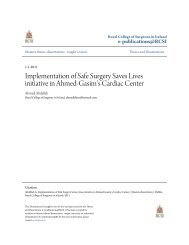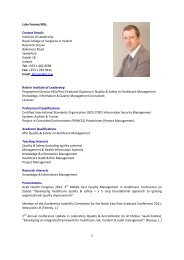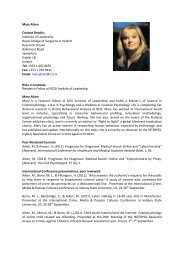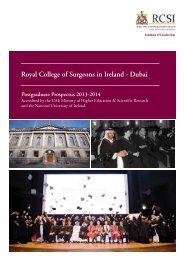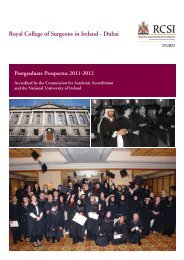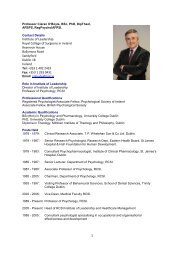Improving the Assessment and Triage of Patients with Mental Illness ...
Improving the Assessment and Triage of Patients with Mental Illness ...
Improving the Assessment and Triage of Patients with Mental Illness ...
Create successful ePaper yourself
Turn your PDF publications into a flip-book with our unique Google optimized e-Paper software.
Planning<br />
Building Commitment<br />
The purpose <strong>of</strong> <strong>the</strong> planning stage is to engage <strong>with</strong> staff <strong>and</strong> key stakeholders in<br />
creating a vision for <strong>the</strong> future (HSE, 2008). Creating a shared vision is instrumental in<br />
clarifying <strong>the</strong> direction <strong>of</strong> <strong>the</strong> change <strong>and</strong> <strong>the</strong>reby motivates individuals to take action<br />
however Kotter (1996) argues that <strong>the</strong> vision must be realistic <strong>and</strong> <strong>the</strong>refore achievable. I was<br />
cognisant that not everyone would share similar views to me. I engaged all staff in<br />
conversation to establish what <strong>the</strong>ir desired future state for <strong>the</strong> department was <strong>and</strong> <strong>the</strong>refore<br />
making it <strong>the</strong>ir vision <strong>and</strong> not just one individual’s aspirations for <strong>the</strong> future.<br />
February 2011.<br />
The change teams spent <strong>the</strong>se meetings designing <strong>the</strong> process <strong>of</strong> implementation.<br />
Firstly a vision had to be agreed upon. Focus group discussions centred on devising <strong>the</strong> vision<br />
statement that would be used to create a picture <strong>of</strong> what all stakeholders imagined for <strong>the</strong><br />
future. This vision needed to incorporate <strong>the</strong> goals set out by <strong>the</strong> Department <strong>of</strong> Health <strong>and</strong><br />
Children (2001) in <strong>the</strong> document ‘Quality <strong>and</strong> Fairness-A System for You’ which included:<br />
better health for everyone, responsive <strong>and</strong> appropriate care delivery <strong>and</strong> high performance.<br />
Rashford <strong>and</strong> Coughlan (2006) recommend a system where groups <strong>of</strong> three or four<br />
individuals would put forward <strong>the</strong>ir ideas on <strong>the</strong>ir vision for <strong>the</strong> organisation. After much<br />
debate but <strong>with</strong> a shared agreement a vision statement was established. This vision statement<br />
would be communicated at regular intervals by <strong>the</strong> change teams. Cartwright <strong>and</strong> Baldwin<br />
(2007) indicate that continuous repetition <strong>of</strong> <strong>the</strong> vision will have <strong>the</strong> greatest impact over<br />
time. The vision we would impart to all key stakeholders was that <strong>of</strong> ‘<strong>the</strong> provision <strong>of</strong> a better<br />
service by <strong>the</strong> improvement in knowledge, assessment <strong>and</strong> care <strong>of</strong> patients <strong>with</strong> mental illness<br />
attending <strong>the</strong> ED’. These teams consisted <strong>of</strong> varying levels <strong>of</strong> expertise which Michie <strong>and</strong><br />
West (2004) consider as important in developing a team approach <strong>and</strong> diversity <strong>of</strong> interest<br />
<strong>and</strong> influence.<br />
24





